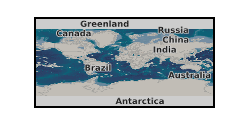.mp4
Type of resources
Topics
Keywords
Contact for the resource
Provided by
Years
Formats
Representation types
Update frequencies
-

The mechanics of olivine deformation play a key role in long-term planetary processes, including the response of the lithosphere to tectonic loading or the response of the solid Earth to tidal forces, and in short-term processes, such as post-seismic creep within the upper mantle. Previous studies have emphasized the importance of grain-size effects in the deformation of olivine. Most of our understanding of the role of grain boundaries in the deformation of olivine is inferred from comparison of experiments on single crystals to experiments on polycrystalline samples, as there are no direct studies of the mechanical properties of individual grain boundaries in olivine. In this study, we use high-precision mechanical testing of synthetic forsterite bicrystals with well characterized interfaces to directly observe and quantify the mechanical properties of olivine grain boundaries. We conduct in-situ micropillar compression tests at high-temperature (700°C) on bicrystals containing low-angle (4• tilt about [100] on (014)) and high-angle (60• tilt about [100] on (011)) boundaries. During the in-situ tests, we observe differences in deformation style between the pillars containing the grain boundary and the pillars in the crystal interior. In the pillars containing the grain boundary, the interface is oriented at ∼ 45° to the loading direction to promote shear. In-situ observations and analysis of the mechanical data indicate that pillars containing the grain boundary consistently support elastic loading to higher stresses than the pillars without a grain boundary. Moreover, the pillars without the grain boundary sustain larger plastic strain. Post-deformation microstructural characterization confirms that under the conditions of these deformation experiments, sliding did not occur along the grain boundary. These observations support the hypothesis that grain boundaries are stronger relative to the crystal interior at these conditions. This data set is associated with the pre-print manuscript with the DOI: 10.22541/essoar.167979601.17867144/v1
-

Herein lies the supporting data for the paper 'Small-scale capillary heterogeneity linked to rapid plume migration during CO2 storage'. We supply experimental, analytical and numerical simulation data used in the paper. The supplied zipped folders follow the same order as the main paper, with codes to reproduce each figure (and those in the supporting information PDF). There are also video files (in the 5_Field_scale_simulation zipped folder) showing the final CO2 plume evolution from the static images in the main paper Figure 4. Descriptions of each of the folders are given below: 0 - README. This contains detailed instructions on the data and using the supplied files. 1 - Scaling analysis. This contains the scaling analysis analytical methods, with figure generation for Figure 1 in the main paper. 2 - Petrophysics. This contains all the petrophysical experimental data, analysis files and core flood simulation files. This is used to produce Figure 2 in the main paper. 3 - Fine_resolution_simulations. This contains the simulation files, Matlab post processing files and figure generation for the fine resolution simulations, presented in Figure 3 in the main paper. 4 - MIP_upscaling. This contains simulations files, Matlab post processing files and figure generation for the macroscopic invasion percolation scheme. The results of this are presented in the supporting information document. 5 - Field_scale_simulation. This contains the simulations files, Matlab post processing files and figure generation for the final field scale simulations in the main manuscript Figure 4 and in the supporting information. In each folder are separate READMEs containing specific information relevant for the included files.
 NERC Data Catalogue Service
NERC Data Catalogue Service